Search Result
Results for "
P2X Receptor
" in MedChemExpress (MCE) Product Catalog:
1
Isotope-Labeled Compounds
| Cat. No. |
Product Name |
Target |
Research Areas |
Chemical Structure |
-
- HY-N5025
-
|
|
P2X Receptor
Apoptosis
|
Inflammation/Immunology
Cancer
|
|
Bullatine A, a diterpenoid alkaloid of the genus Aconitum, possesses anti-rheumatic, anti-inflammatory and anti-nociceptive effects. Bullatine A is a potent P2X7 antagonist, inhibits ATP-induced cell death/apoptosis and P2X receptor-mediated inflammatory responses . Bullatine A attenuates pain hypersensitivity, regardless of the pain models employed .
|
-
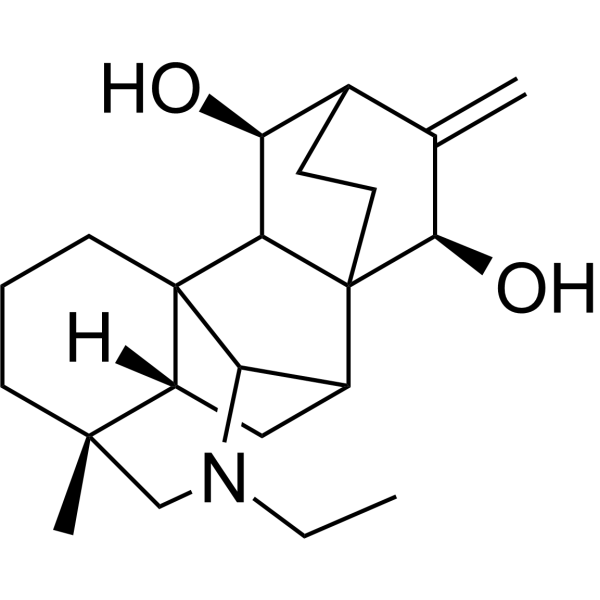
-
- HY-139627
-
-
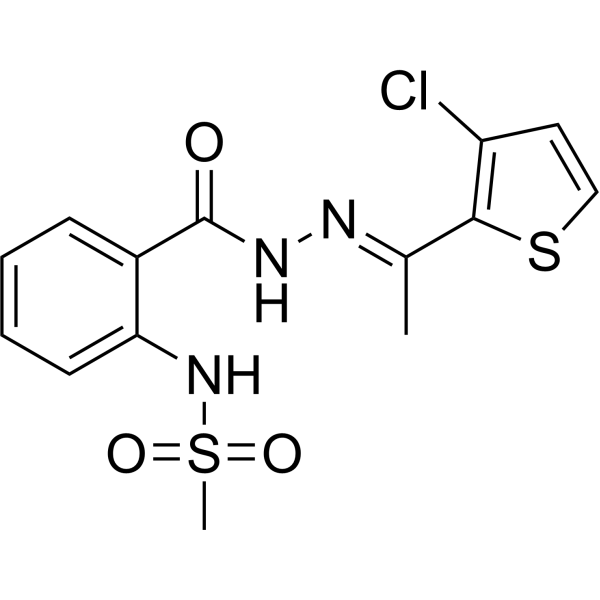
-
- HY-108667
-
|
|
P2X Receptor
|
Others
|
|
TNP-ATP triethylammonium is a selective P2X receptor antagonist. TNP-ATP triethylammonium shows antinociceptive effects in rats .
|
-

-
- HY-101077
-
|
|
|
|
|
Iso-PPADS tetrasodium is a P2X-purinoceptor antagonist. Iso-PPADS tetrasodium inhibits P2X1 and P2X3 receptor with IC50s of 43 nM and 84 nM. Iso-PPADS tetrasodium is protective against ventilator-induced brain injury (VIBI) .
|
-
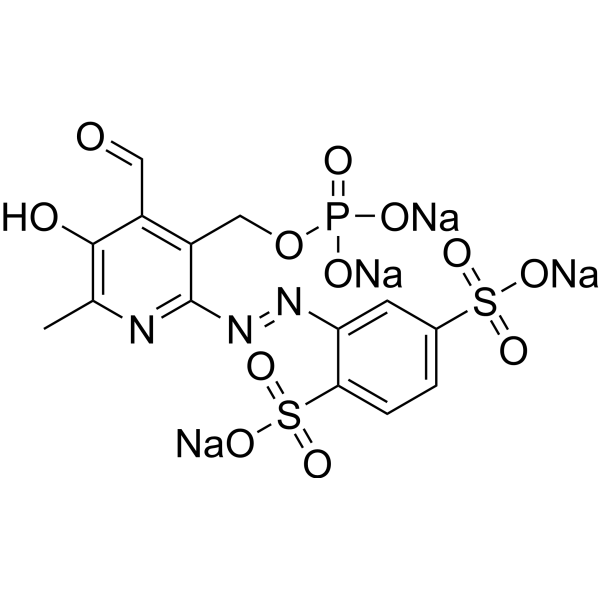
-
- HY-134262
-
|
8-Bromoadenosine 5'-triphosphate; 8-Br-ATP
|
P2X Receptor
|
Cancer
|
|
8-Bromo-ATP (8-Bromoadenosine 5'-triphosphate), an ATP analogue, is a purinergic P2X receptor agonist. 8-Bromo-ATP shows cytotoxic to multiple myeloma cells with an IC50 of 23.1 μM .
|
-

-
- HY-136254
-
|
|
P2X Receptor
|
Inflammation/Immunology
Cancer
|
|
BzATP triethylammonium salt acts as a P2X receptor agonist with pEC50s of 8.74, 5.26, 7.10, 7.50, 6.19, 6.31, 5.33 for P2X1, P2X2, P2X3, P2X2/3, P2X4 and P2X7, respectively . BzATP triethylammonium salt is potent at P2X7 receptors with EC50s of 3.6 μM and 285 μM for rat P2X7 and mouse P2X7, respectively .
|
-
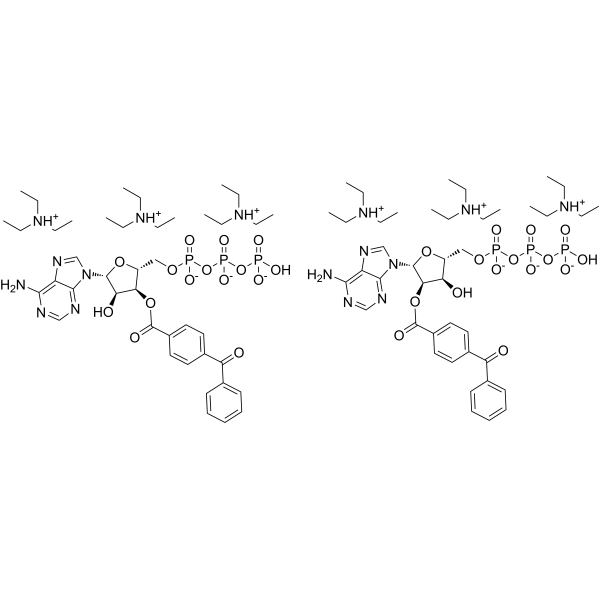
-
- HY-19978
-
|
|
|
|
|
RO-3 is a potent, CNS-penetrant, and orally active P2X3 and P2X2/3 antagonist with pIC50s of 5.9 and 7.0 for human homomultimeric P2X3 and heteromultimeric P2X2/3 receptors, respectively. RO-3 shows selectivity for P2X3 and P2X2/3 over all other functional homomultimeric P2X receptors (IC50 >10 μM at P2X1,2,4,5,7) .
|
-
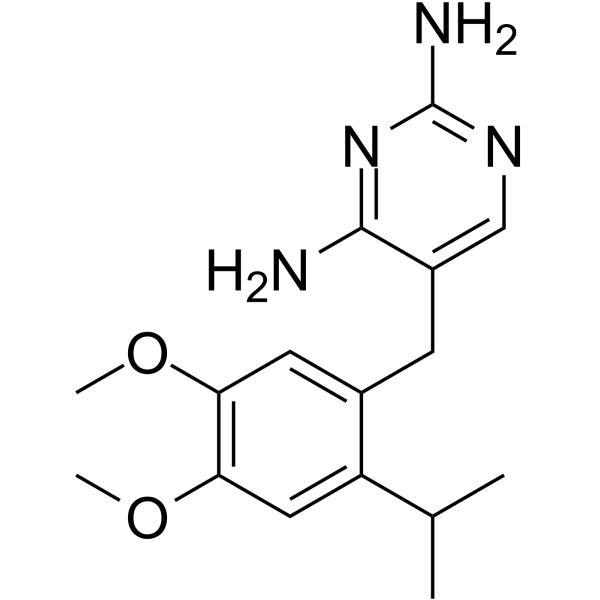
-
- HY-148558
-
|
|
P2X Receptor
|
Neurological Disease
|
|
P2X7 receptor antagonist-3 is a potent P2X7 receptor antagonist with P2X7R IC50 values of 4.2 nM in humans and 6.8 nM in rats .
|
-
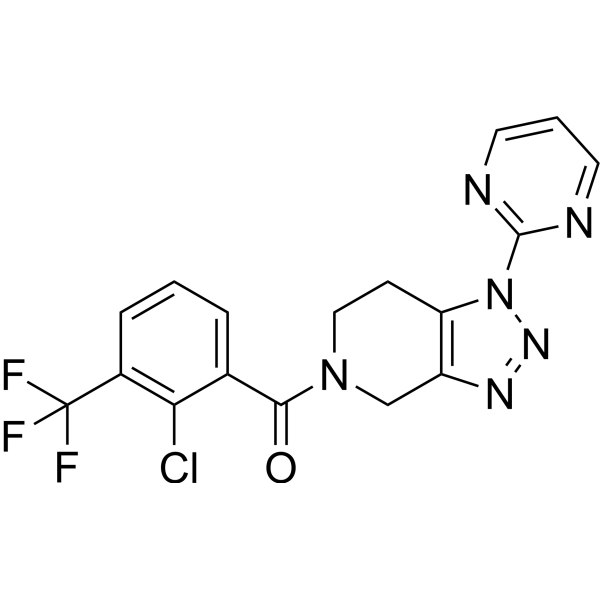
-
- HY-150059
-
-
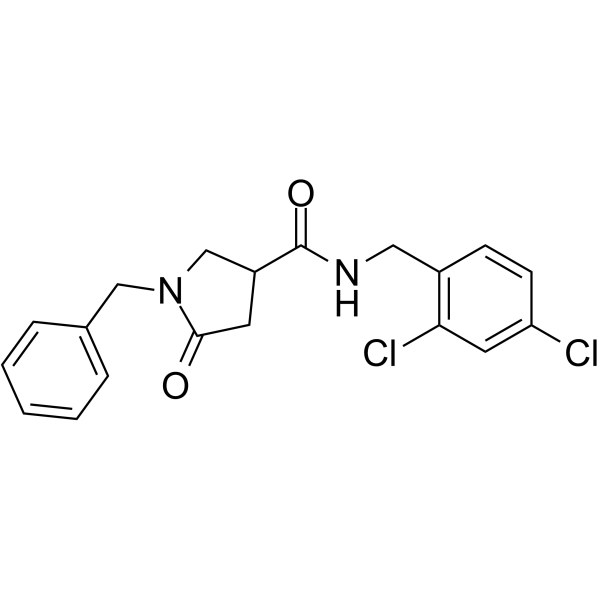
-
- HY-101044
-
|
|
|
|
|
PPADS tetrasodiuma is a non-selective P2X receptor antagonist. PPADS tetrasodiuma blocks recombinant P2X1, -2, -3, -5 with IC50s ranging from 1 to 2.6 μM. PPADS tetrasodiuma blocks native P2Y2-like (IC50~0.9 mM) and recombinant P2Y4 (IC50~15 mM) receptors. PPADS tetrasodiuma is an inhibitor of the reverse mode of the Na/Ca 2+ exchanger in guinea pig airway smooth muscle .
|
-
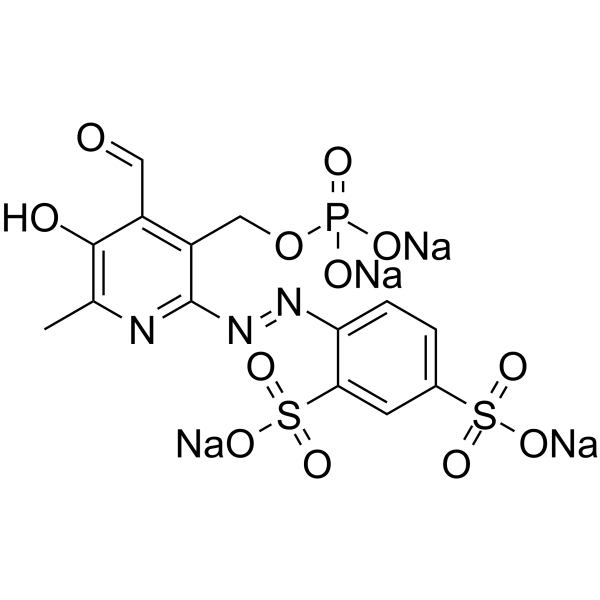
-
- HY-155194
-
|
|
Others
|
Inflammation/Immunology
|
|
P2X7 receptor antagonist-4 (Compound 14a) is a P2X7R antagonist. The P2X7 receptor antagonist-4 values of P2X7R IC50 in human and mouse are 64.7 and 10.1 nM, respectively. P2X7 receptor antagonist-4 can inhibit the activation of NLRP3 inflammasome, thereby inhibiting the expression of caspase-1, gasdermin D, IL-1β and IL-18 in the damaged kidney of sepsis mice .
|
-
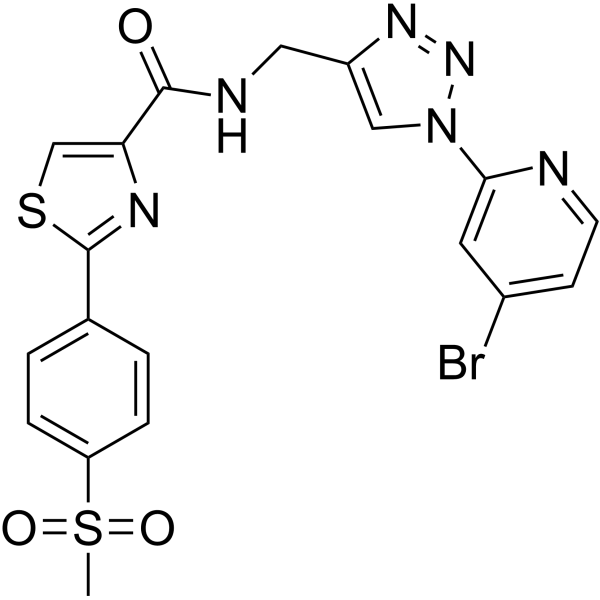
-
- HY-101588
-
|
MK-7264; AF-219
|
P2X Receptor
|
Inflammation/Immunology
|
|
Gefapixant is an orally active and potent purinergic P2X3 receptor (P2X3R) antagonist, with IC50 values of ~30 nM versus recombinant hP2X3 homotrimers and 100-250 nM at hP2X2/3 heterotrimeric receptors. Gefapixant can be used for the research of chronic cough and knee osteoarthritis .
|
-
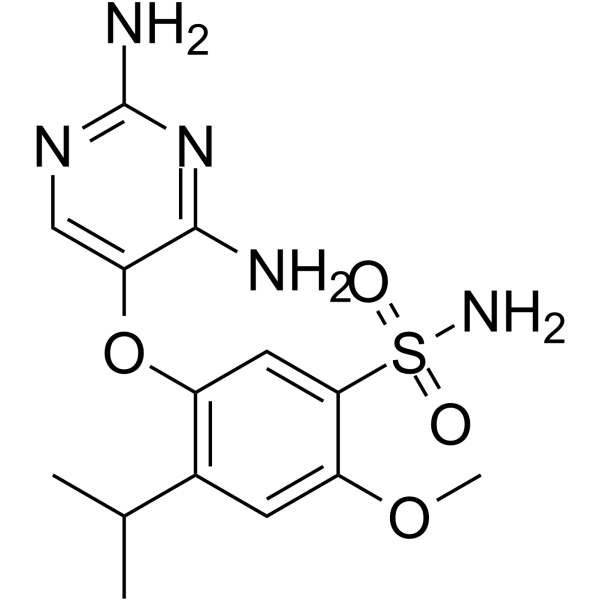
-
- HY-101588A
-
|
MK-7264 citrate; AF-219 citrate
|
P2X Receptor
|
Inflammation/Immunology
|
|
Gefapixant citrate is an orally active and potent purinergic P2X3 receptor (P2X3R) antagonist, with IC50 values of ~30 nM versus recombinant hP2X3 homotrimers and 100-250 nM at hP2X2/3 heterotrimeric receptors. Gefapixant citrate can be used for the research of chronic cough and knee osteoarthritis .
|
-
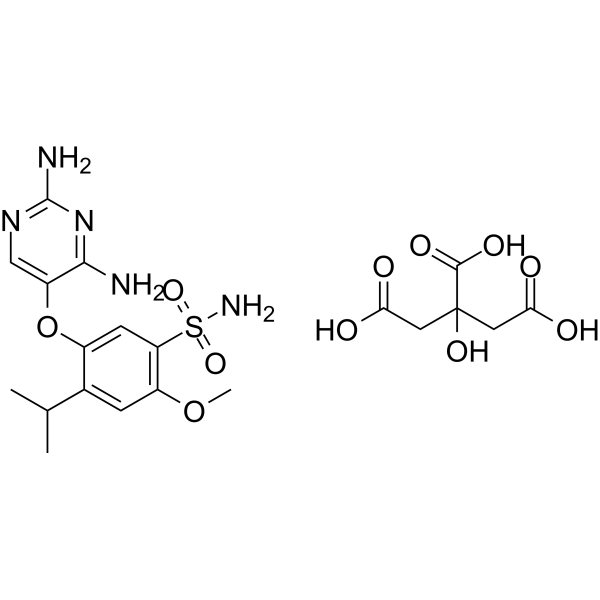
-
- HY-131502
-
|
|
P2X Receptor
|
Inflammation/Immunology
|
|
Taspine is a natural product with anti-inflammatory activity. Taspine suppresses P2X4 receptor activity via PI3K inhibition. Taspine inhibits pro-inflammatory signalling via inhibition of P2X4 receptors in macrophage .
|
-
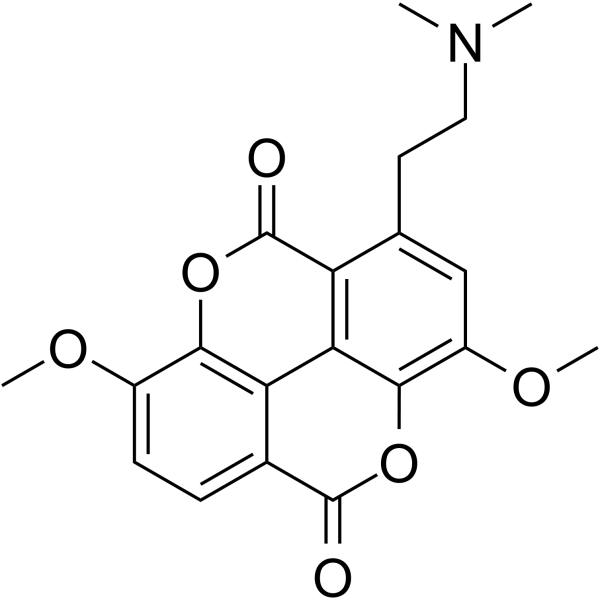
-
- HY-108673
-
|
|
P2X Receptor
|
Cancer
|
|
Ro 0437626 is a selective purinergic (P2X1) receptor antagonist (IC50 = 3 μM), but shows low affinity for P2X2, P2X3 and P2X2/3 receptors (IC50 > 100 μM) .
|
-

-
- HY-135976
-
|
|
P2X Receptor
|
Neurological Disease
Inflammation/Immunology
|
|
P2X3 antagonist 34 is a potent, selective and orally active P2X3 homotrimeric receptor antagonist with IC50s of 25 nM, 92 nM and 126 nM for human P2X3, rat P2X3 and guinea pig P2X3 receptors, respectively. P2X3 antagonist 34 is less active against human, rat and guinea pig P2X2/3 heterotrimeric receptors. P2X3 antagonist 34 has strong anti-tussive effect .
|
-
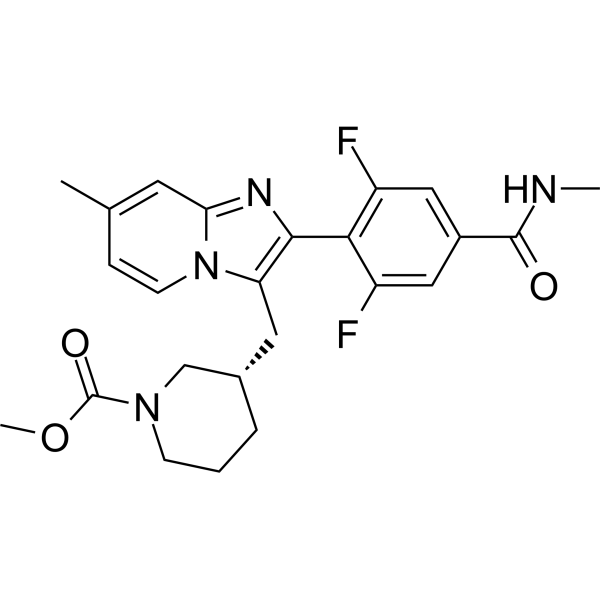
-
- HY-128402
-
-

-
- HY-18725
-
|
|
|
|
|
P2X7-IN-2 (compound 58) is a P2X7 receptor inhibitor. P2X7-IN-2 inhibits IL-Iβ release with an IC50 value of 0.01 nM. P2X7-IN-2 can be used for the research of autoimmunity, inflammation and cardiovascular disease .
|
-
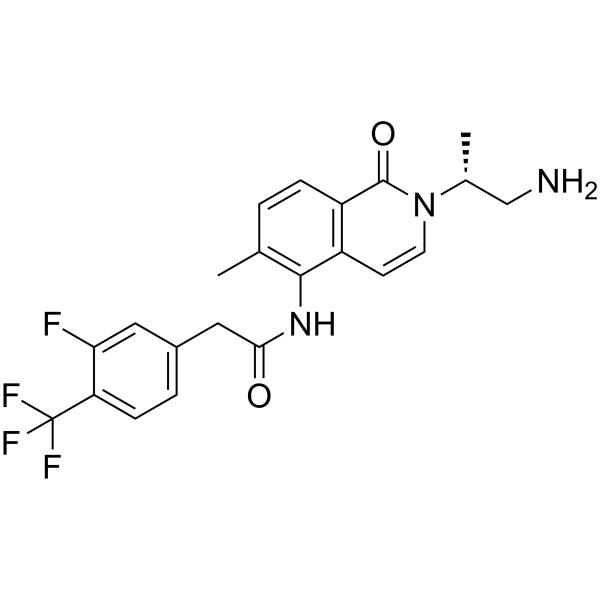
-
- HY-134440A
-
|
|
P2X Receptor
|
Inflammation/Immunology
|
|
α,β-Methylene ATP, a phosphonic analog of ATP, is a P2X3 and P2X7 receptor ligand. α,β-Methylene ATP is a highly selective agonist for P2X1 and P2X3, with practically no activity at P2X2,4-7 .
|
-
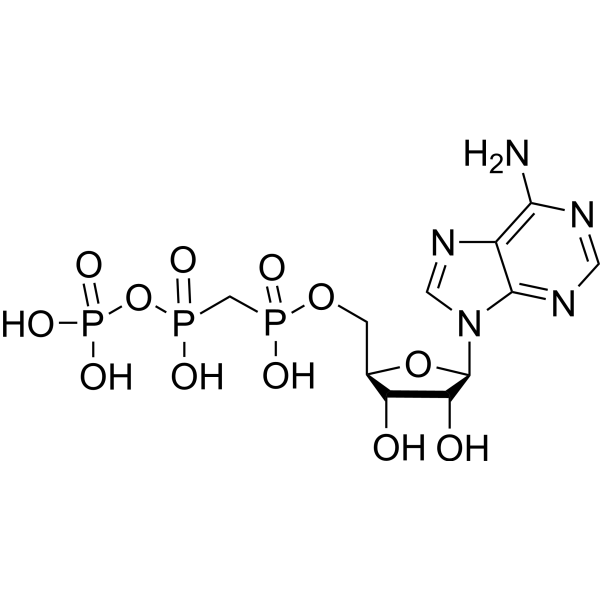
-
- HY-14483
-
AF-353
1 Publications Verification
Ro-4
|
P2X Receptor
|
Cancer
|
|
AF-353 (Ro-4) is a potent, selective and orally bioavailable P2X3/P2X2/3 receptor antagonist, with a pIC50 of 8.0 for both human and rat P2X3, and with a pIC50 of 7.3 for human P2X2/3 .
|
-
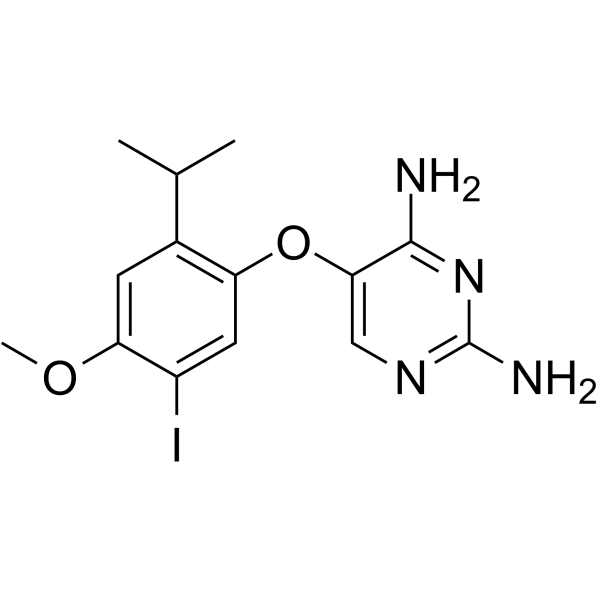
-
- HY-18725A
-
-
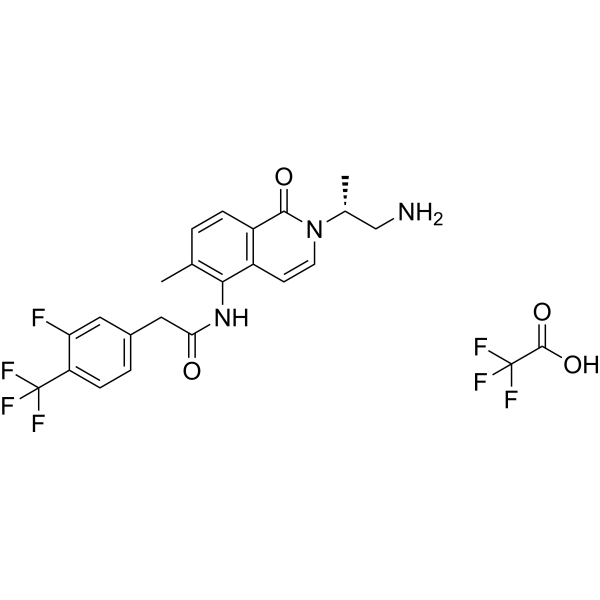
-
- HY-108652
-
|
|
P2X Receptor
|
Inflammation/Immunology
|
|
α,β-Methylene-ATP trisodium, a phosphonic analog of ATP, is a P2X3 and P2X7 receptor ligand . α,β-Methylene-ATP trisodium is a highly selective agonist for P2X1 and P2X3, with practically no activity at P2X2,4-7 .
|
-
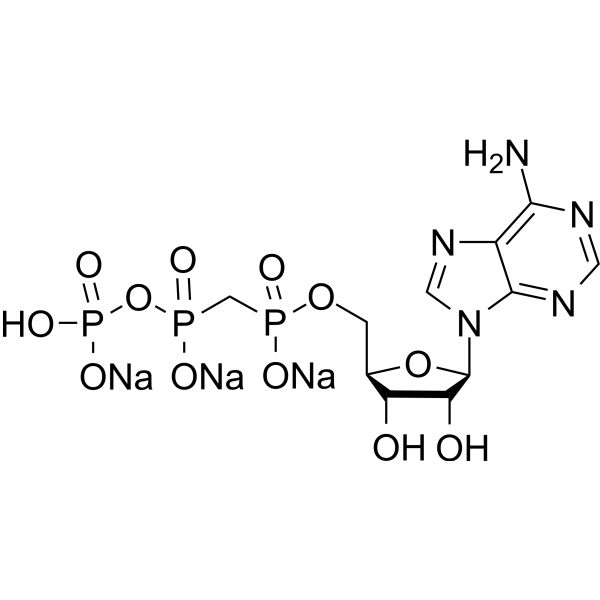
-
- HY-134440
-
|
|
P2X Receptor
|
Inflammation/Immunology
|
|
α,β-Methylene ATP dilithium, a phosphonic analog of ATP, is a P2X3 and P2X7 receptor ligand . α,β-Methylene ATP dilithium is a highly selective agonist for P2X1 and P2X3, with practically no activity at P2X2,4-7 .
|
-

-
- HY-108676
-
|
|
P2X Receptor
|
Neurological Disease
|
|
NF023 hexasodium is a selective and competitive P2X1 receptor antagonist, with IC50 values of 0.21 μM, 28.9 μM, > 50 μM and > 100 μM for human P2X1, P2X3, P2X2, and P2X4-mediated responses respectively .
|
-
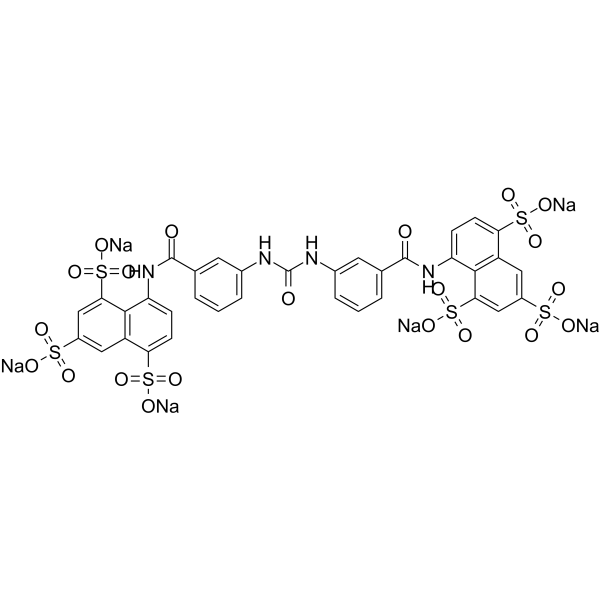
-
- HY-50697
-
|
|
P2X Receptor
|
Neurological Disease
|
|
A-740003 is a potent, selective and competitive P2X7 receptor antagonist with IC50 values are 18 and 40 nM for rat and human P2X7 receptors, respectively.
|
-
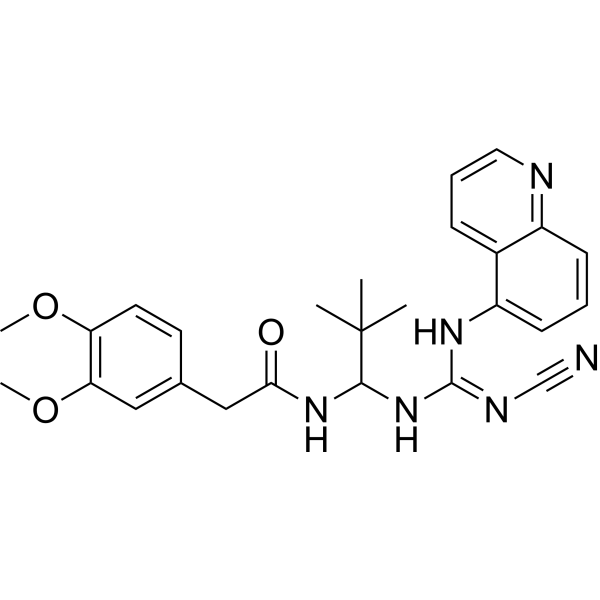
-
- HY-137451
-
|
S-600918
|
P2X Receptor
|
Neurological Disease
|
|
Sivopixant (S-600918) is a potent and selective P2X3 receptor antagonist (P2X3 IC50=4.2 nM; P2X2/3 IC50=1100 nM). Sivopixant shows strong analgesic effect .
|
-

-
- HY-145466
-
|
|
P2X Receptor
|
Neurological Disease
|
|
EVT-401 (P2X7 receptor antagonist-1) is a purinergic P2X7 receptor antagonist. EVT-401 has efficacy of combating neuroinflammation .
|
-
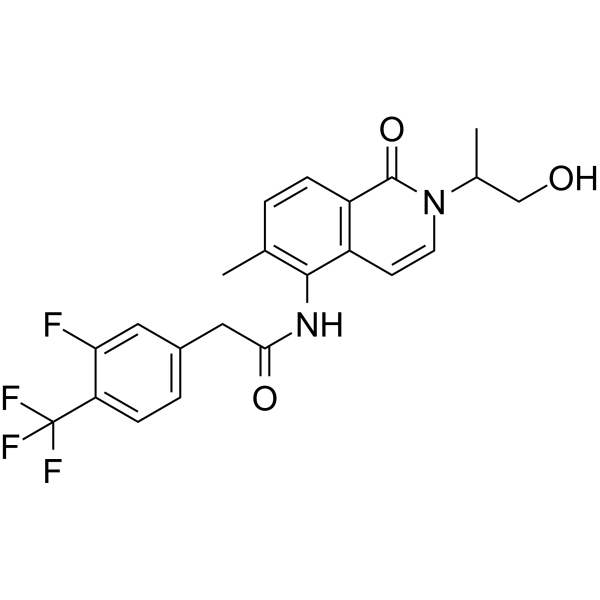
-
- HY-124300
-
|
|
P2X Receptor
|
Others
|
|
JNJ-54166060 is a potent and selective P2X7 receptor antagonist, with IC50s of 4/115/72 nM for human/rat/mouse P2X7 receptor, respectively .
|
-
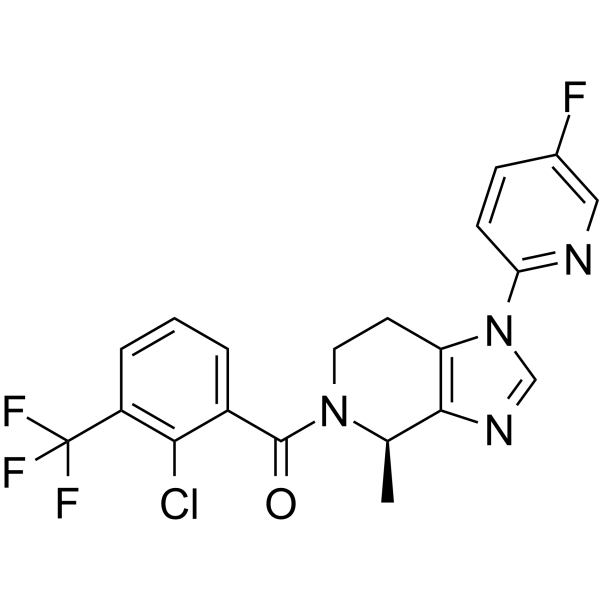
-
- HY-15568
-
|
|
P2X Receptor
|
Neurological Disease
Inflammation/Immunology
|
|
A-317491 is a potent, selective and non-nucleotide antagonist of P2X3 and P2X2/3 receptors, with Kis of 22, 22, 9, and 92 nM for hP2X3, rP2X3, hP2X2/3, and rP2X2/3, respectively. A-317491 is highly selective (IC50>10 μM) over other P2 receptors and other neurotransmitter receptors, ion channels, and enzymes. A-317491 reduces inflammatory and neuropathic pain by blocking P2X3 and P2X2/3 receptor-mediated calcium flux .
|
-
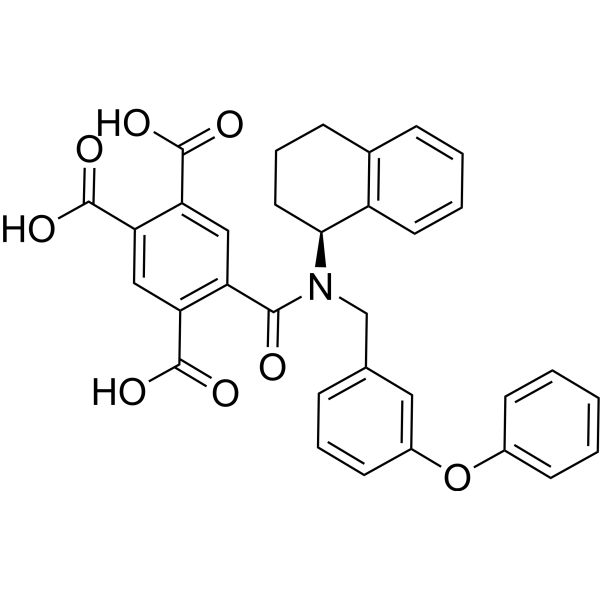
-
- HY-15568A
-
|
|
P2X Receptor
|
Neurological Disease
Inflammation/Immunology
|
|
A-317491 sodium salt hydrate is a potent, selective and non-nucleotide antagonist of P2X3 and P2X2/3 receptors, with Kis of 22, 22, 9, and 92 nM for hP2X3, rP2X3, hP2X2/3, and rP2X2/3, respectively. A-317491 sodium salt hydrate is highly selective (IC50>10 μM) over other P2 receptors and other neurotransmitter receptors, ion channels, and enzymes. A-317491 sodium salt hydrate reduces inflammatory and neuropathic pain by blocking P2X3 and P2X2/3 receptor-mediated calcium flux .
|
-
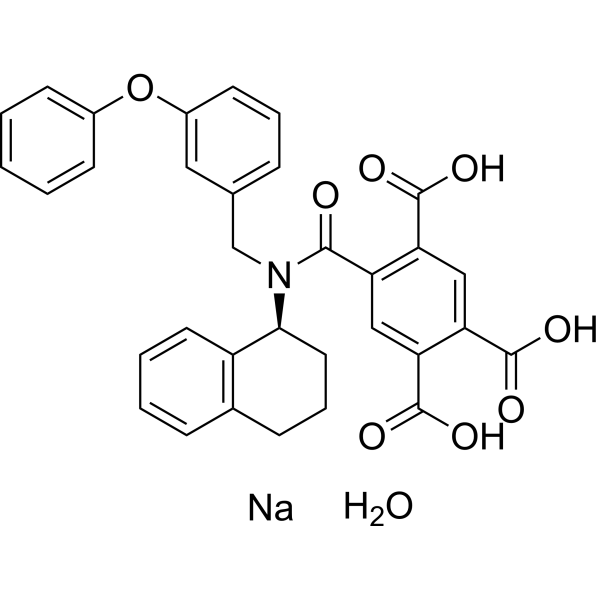
-
- HY-100483
-
|
|
P2X Receptor
|
Cancer
|
|
A-804598 is a CNS penetrant, competitive and selective P2X7 receptor antagonist with IC50s of 9 nM, 10 nM and 11 nM for mouse, rat and human P2X7 receptors, respectively .
|
-
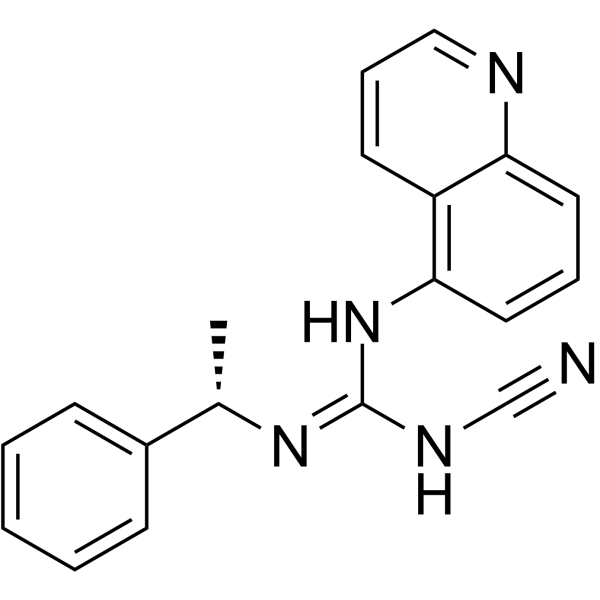
-
- HY-15487
-
-

-
- HY-13954
-
|
|
P2X Receptor
|
Neurological Disease
Inflammation/Immunology
|
|
A 839977 is a P2X7 selective antagonist; it blocks BzATP-evoked calcium influx at recombinant human, rat and mouse P2X7 receptors (IC50 values are 20 nM, 42 nM and 150 nM respectively) and reduces inflammatory and neuropathic pain in animal models; the antihyperalgesic effects of P2X7 receptor blockade are mediated by blocking the release of IL-1beta .
|
-

-
- HY-143576
-
-
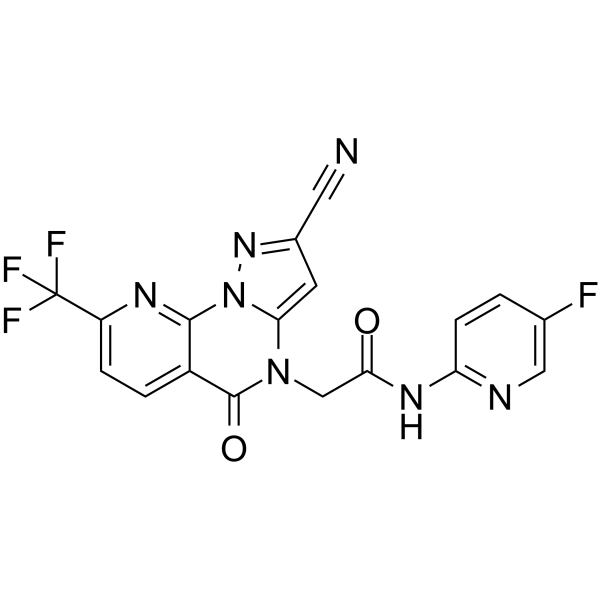
-
- HY-101308
-
|
|
|
|
|
MRS2179 tetrasodium is a competitive P2Y1 receptor antagonist, with a Kb of 102 nM and a pA2 of 6.99 for turkey P2Y1 receptor. MRS2179 tetrasodium is selective for P2Y1 over P2X1 (IC50=1.15 µM), P2X3 (12.9 µM), P2X2, P2X4, P2Y2, P2Y4, and P2Y6 receptors . MRS2179 tetrasodium inhibits platelet aggregation .
|
-
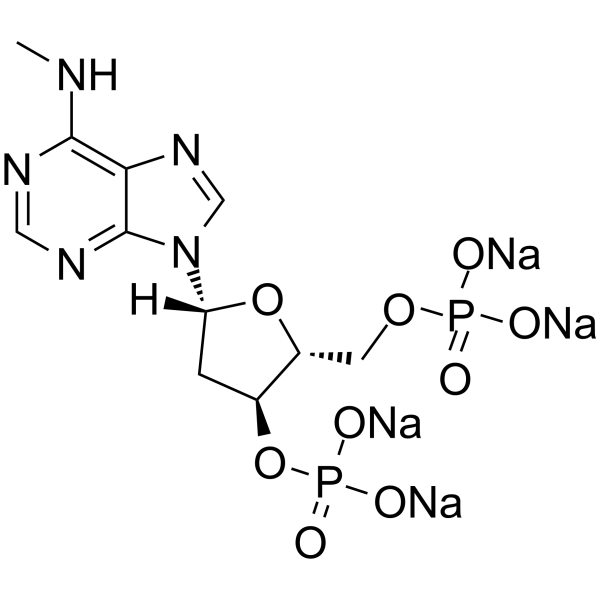
-
- HY-101308A
-
|
|
P2Y Receptor
|
Cardiovascular Disease
|
|
MRS2179 tetrasodium hydrate is a competitive P2Y1 receptor antagonist, with a Kb of 102 nM and a pA2 of 6.99 for turkey P2Y1 receptor. MRS2179 tetrasodium hydrate is selective for P2Y1 over P2X1 (IC50=1.15 µM), P2X3 (12.9 µM), P2X2, P2X4, P2Y2, P2Y4, and P2Y6 receptors . MRS2179 tetrasodium hydrate inhibits platelet aggregation .
|
-
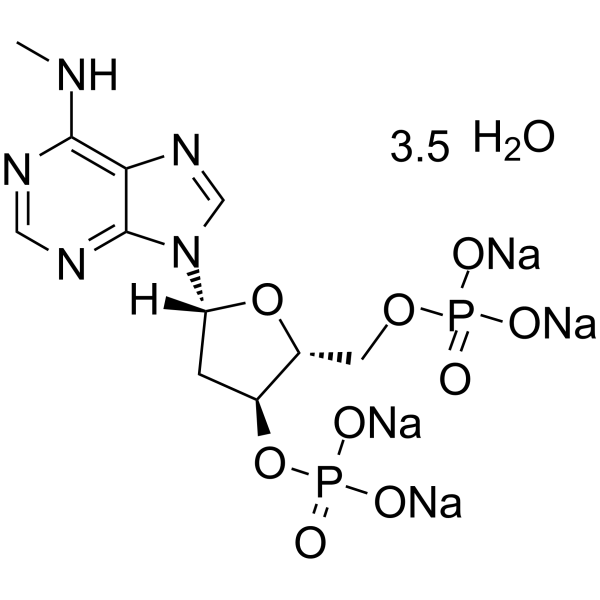
-
- HY-151546
-
|
|
P2X Receptor
|
Neurological Disease
|
|
MRS4596 is a potent and selective P2X4 receptor antagonist with an IC50 value of 1.38 μM for human P2X4 receptor. MRS4596 has neuroprotective and neuro-rehabilitative activities in ischemic stroke model. MRS4596 can be used in research of ischemic stroke .
|
-

-
- HY-D0976
-
|
|
P2X Receptor
HIV
|
Infection
|
|
NF279 is a potent selective and reversible P2X1 receptor antagonist, with an IC50 of 19 nM. NF279 displays good selectivity over P2X2, P2X3 (IC50=1.62 μM), P2X4 (IC50>300 μM). NF279 is a dual HIV-1 coreceptor inhibitor that interferes with the functional engagement of CCR5 and CXCR4 by Env .
|
-
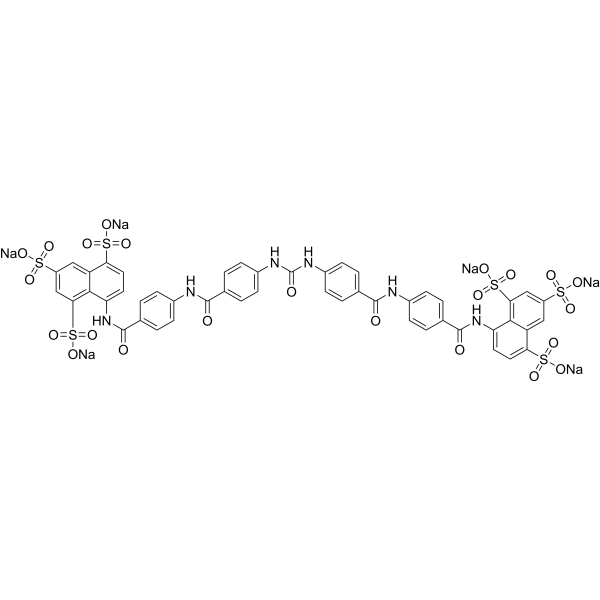
-
- HY-19888
-
|
|
|
|
|
GSK-1482160 is an orally available negative allosteric modulator of the P2X7 receptor. P2X7 receptors are involved in the production of pro-inflammatory cytokines, such as Il-1β, by central and peripheral immune cells. GSK-1482160 has the potential for the research of inflammation diseases .
|
-
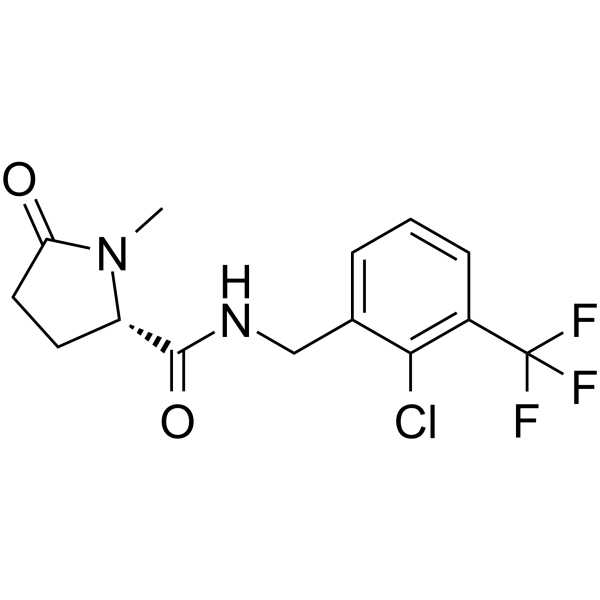
-
- HY-N1478
-
|
|
|
|
|
Gardenoside is a natural compound found in Gardenia fruits, with hepatoprotective properties. Gardenoside suppresses the pain of chronic constriction injury by regulating the P2X3 and P2X7 receptors. Gardenoside has an inhibitory effect on free fatty acids (FFA)-induced cellular steatosis .
|
-

-
- HY-123205
-
|
|
Histamine Receptor
P2X Receptor
5-HT Receptor
|
Inflammation/Immunology
|
|
Oxatomide is a potent and orally active dual H1-histamine receptor and P2X7 receptor antagonist with antihistamine and anti-allergic activity. Oxatomide almost completely blocks the ATP-induced current in human P2X7 receptors (IC50 of 0.95 μM). Oxatomide inhibits ATP-induced Ca 2+ influx with an IC50 value of 0.43 μM and also inhibits serotonin .
|
-
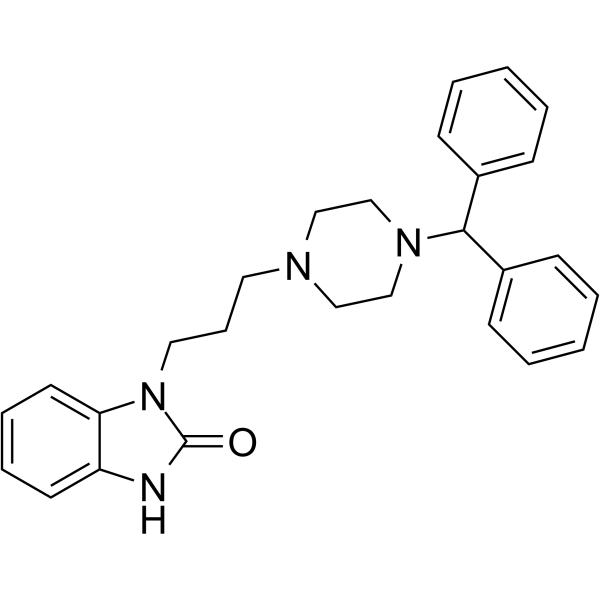
-
- HY-16322
-
|
YM-529
|
P2X Receptor
Apoptosis
|
Cancer
|
|
Minodronic acid (YM-529) is a third-generation bisphosphonate that directly and indirectly prevents proliferation, induces apoptosis, and inhibits metastasis of various types of cancer cells. Minodronic acid (YM-529) is an antagonist of purinergic P2X2/3 receptors involved in pain .
|
-
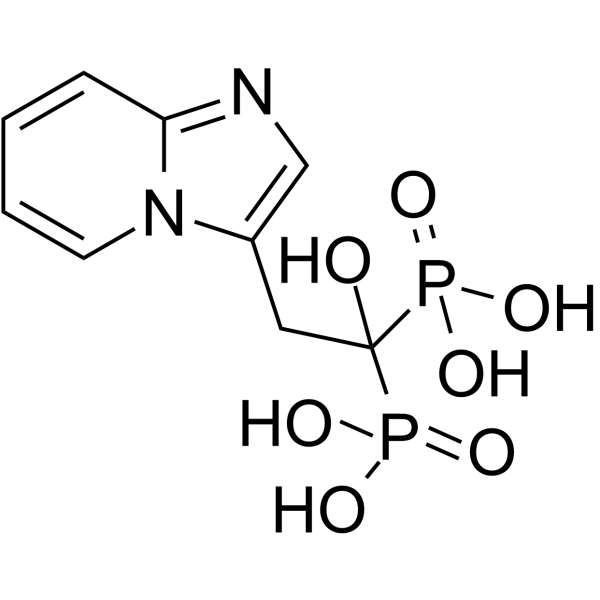
-
- HY-15469
-
|
|
P2X Receptor
|
Neurological Disease
|
|
GW791343 dihydrochloride is a potent human P2X7 receptor negative allosteric modulator (exhibits species-specific activity), produces a non-competitive antagonist effect on human P2X7 receptor, with a pIC50 of 6.9-7.2. GW791343 dihydrochloride can enhance ATP rhythm. GW791343 dihydrochloride can be used in study of neurological disease .
|
-
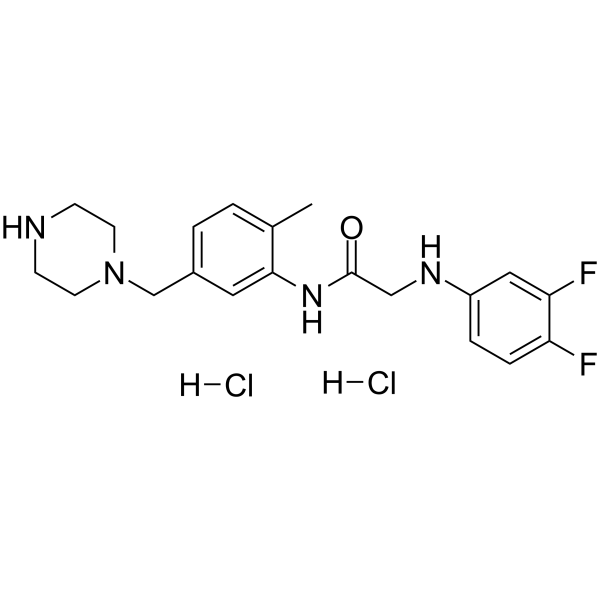
-
- HY-15470
-
|
|
P2X Receptor
|
Neurological Disease
|
|
GW791343 trihydrochloride is a potent human P2X7 receptor negative allosteric modulator (exhibits species-specific activity), produces a non-competitive antagonist effect on human P2X7 receptor, with a pIC50 of 6.9-7.2. GW791343 trihydrochloride can enhance ATP rhythm. GW791343 trihydrochloride can be used in study of neurological disease .
|
-
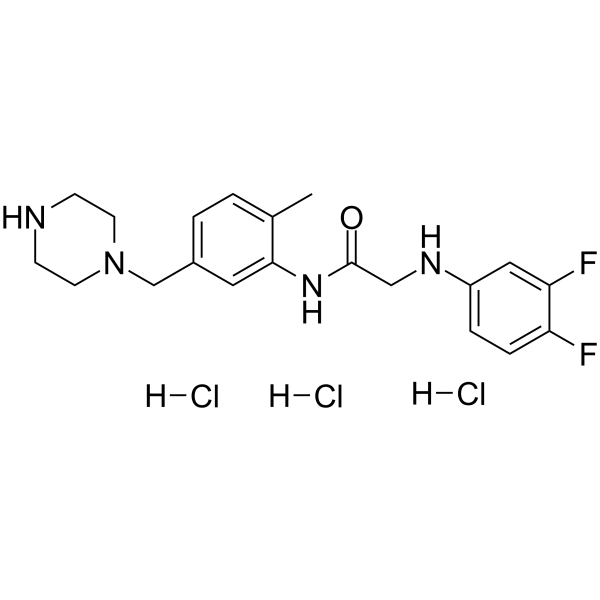
-
- HY-15488A
-
-

-
- HY-15488
-
-
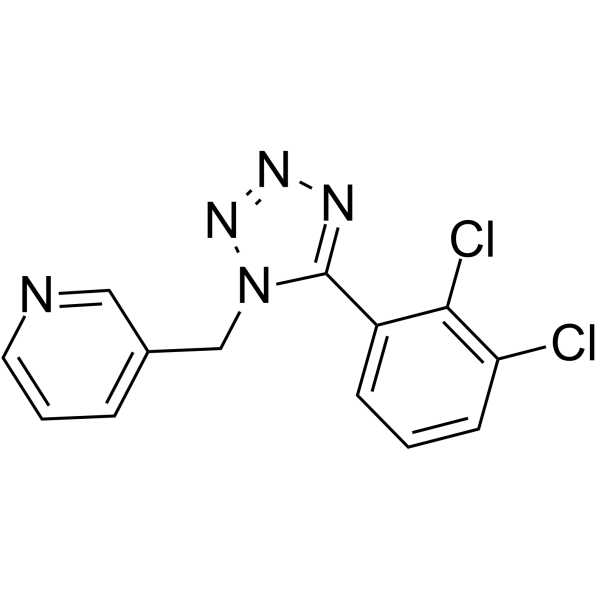
-
- HY-108669
-
|
|
P2X Receptor
|
Neurological Disease
Cancer
|
|
AZ10606120 dihydrochloride is a selective, high affinity antagonist for P2X7 receptor (P2X7R) at human and rat with an IC50 of about 10 nM. AZ10606120 dihydrochloride is little or no effect at other P2XR subtypes. AZ10606120 dihydrochloride has anti-depressant effects and reduces tumour growth .
|
-
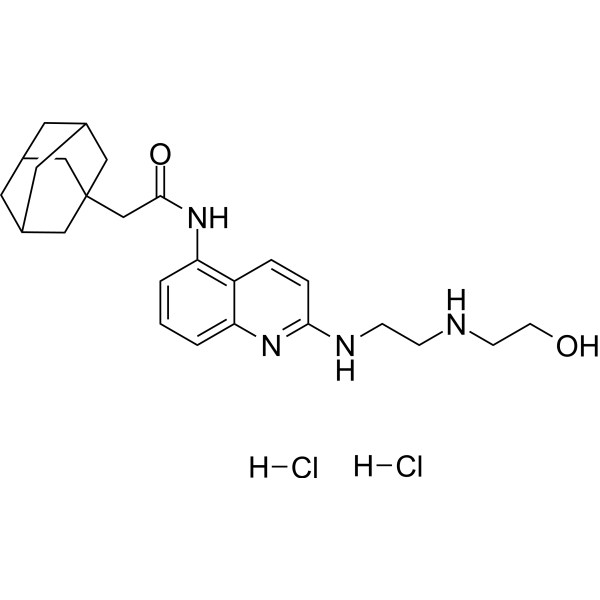
-
- HY-112461A
-
|
|
P2X Receptor
|
Cardiovascular Disease
|
|
NF449 octasodium is a highly potent P2X1 receptor antagonist, with IC50s of 0.28, 0.69, and 120 nM for rP2X1, rP2X1+5, P2X2+3, respectively. NF449 octasodium is a Gsα-selective G Protein antagonist. NF449 octasodium suppresses the rate of GTP[γS] binding to Gsα-s, inhibits the stimulation of adenylyl cyclase activity, and blocks the coupling of β-adrenergic receptors to Gs .
|
-
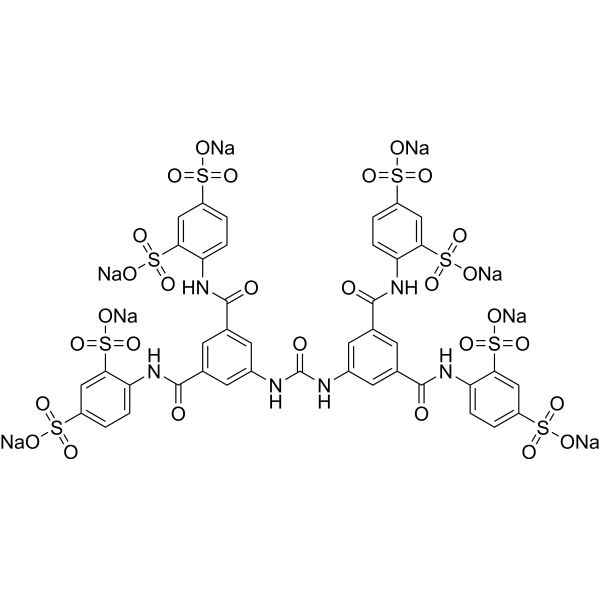
-
- HY-117508
-
|
|
P2X Receptor
|
Neurological Disease
|
|
JNJ-54175446 is a potent and selective brain penetrant P2X7 receptor antagonist, with pIC50s of 8.46 and 8.81 for hP2X7 receptor and rP2X7 receptor, respectively.
|
-
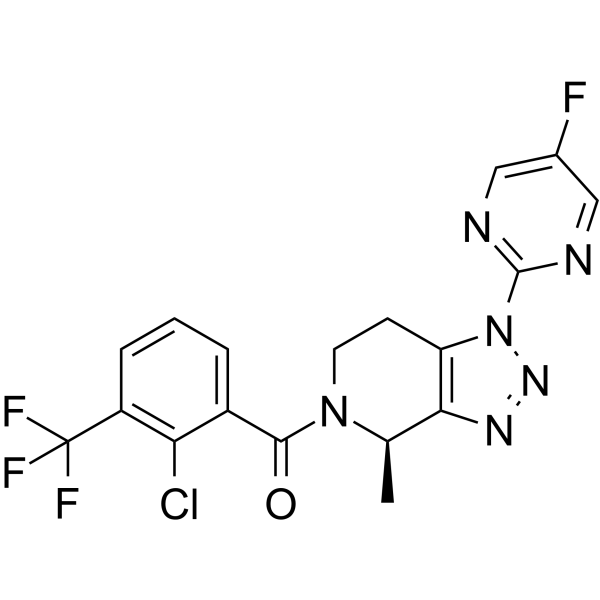
-
- HY-16322S
-
|
YM-529-d4
|
Isotope-Labeled Compounds
P2X Receptor
Apoptosis
|
Cancer
|
|
Minodronic acid-d4 is deuterium labeled Minodronic acid. Minodronic acid (YM-529) is a third-generation bisphosphonate that directly and indirectly prevents proliferation, induces apoptosis, and inhibits metastasis of various types of cancer cells. Minodronic acid (YM-529) is an antagonist of purinergic P2X2/3 receptors involved in pain[1][2].
|
-

- HY-109170
-
|
BAY 1817080
|
P2X Receptor
|
Inflammation/Immunology
|
|
Eliapixant (BAY 1817080) is a potent and selective antagonist of P2X3 receptor, with an IC50 of 8 nM. Eliapixant can be used for the research of refractory chronic cough .
|
-
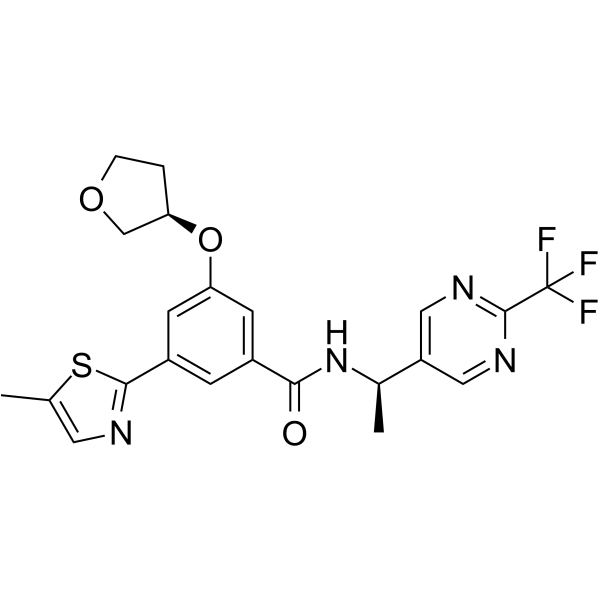
- HY-151547
-
|
|
P2X Receptor
|
Neurological Disease
|
|
MRS4719 is a potent P2X4 receptor antagonist with an IC50 value of 0.503 μM for human P2X4 receptor. MRS4719 can reduce infarct volume and reduce brain atrophy, showing neuroprotective and neuro-rehabilitative activities in ischemic stroke model. MRS4719 also reduces ATP-induced [Ca 2+]i influx in primary human monocyte-derived macrophages. MRS4719 can be used to research ischemic stroke .
|
-
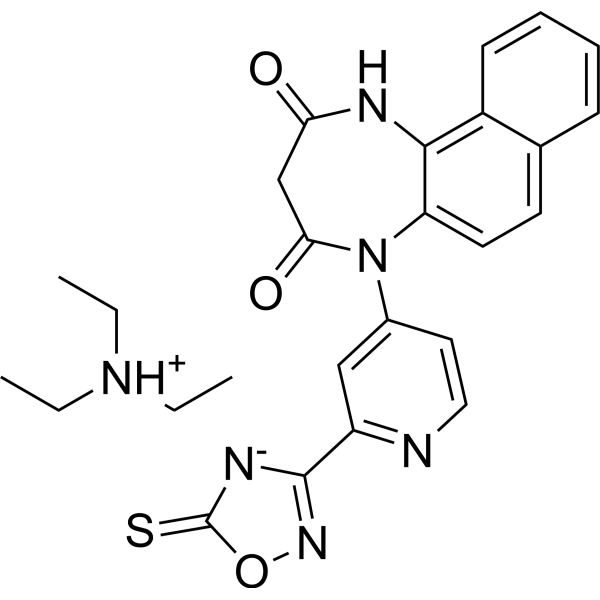
- HY-134807
-
|
|
P2X Receptor
5-HT Receptor
Autophagy
|
Cancer
|
|
Indophagolin is a potent, indoline-containing autophagy inhibitor (IC50=140 nM). Indophagolin antagonizes the purinergic receptor P2X4 as well as P2X1 and P2X3 with IC50s of 2.71, 2.40 and 3.49 μM, respectively. Indophagolin also antagonizes the Gq-protein-coupled P2Y4, P2Y6, and P2Y11 receptors (IC50s =3.4~15.4 μM). Indophagolin has a strong antagonistic effect on serotonin receptor 5-HT6 (IC50=1.0 μM) and a moderate effect on receptors 5-HT1B, 5-HT2B, 5-HT4e, and 5-HT7 .
|
-
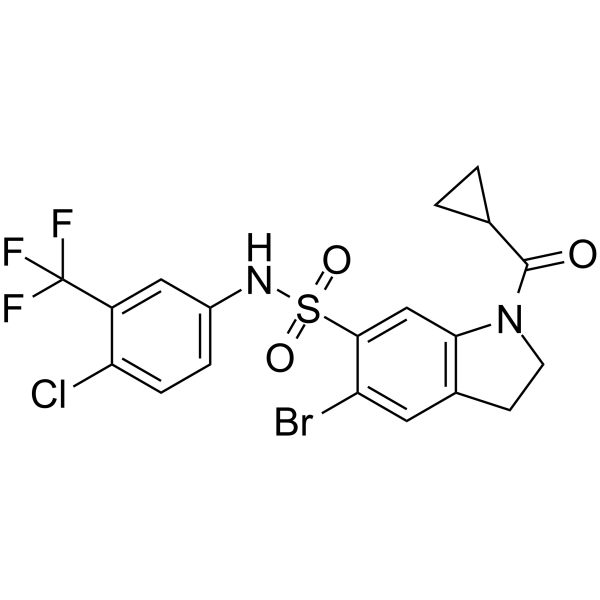
- HY-137451A
-
|
(E/Z)-S-600918
|
P2X Receptor
|
Inflammation/Immunology
|
|
(E/Z)-Sivopixant ((E/Z)-S-600918) is a potent P2X3 receptor antagonist with an IC50 of 4 nM. (E/Z)-Sivopixant can be used for respiratory diseases research .
|
-

- HY-P1330
-
|
|
P2X Receptor
|
Inflammation/Immunology
|
|
Purotoxin 1 is a P2X3 receptor inhibitor. Purotoxin 1 shows antinociceptive properties in animal models of inflammatory pain. Purotoxin 1 can be isolated from the venom of the wolf spider Geolycosa sp .
|
-
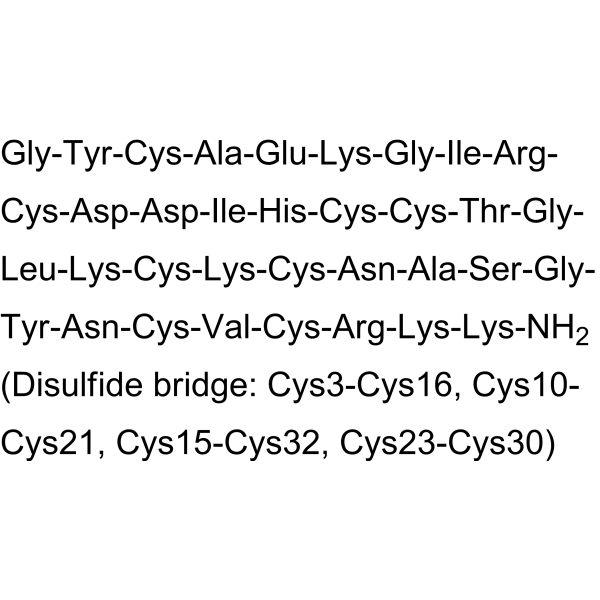
- HY-D1199
-
|
|
P2X Receptor
P2Y Receptor
|
Inflammation/Immunology
|
|
Blue FPG-A trisodium is a selective antagonist of P2X1 receptor and P2Y1 receptor with IC50 values of 35.5 μM and 2.6 μM, respectively. Blue FPG-A trisodium is a structural isomer of the components of Reactive Blue 2 (RB2) .
|
-
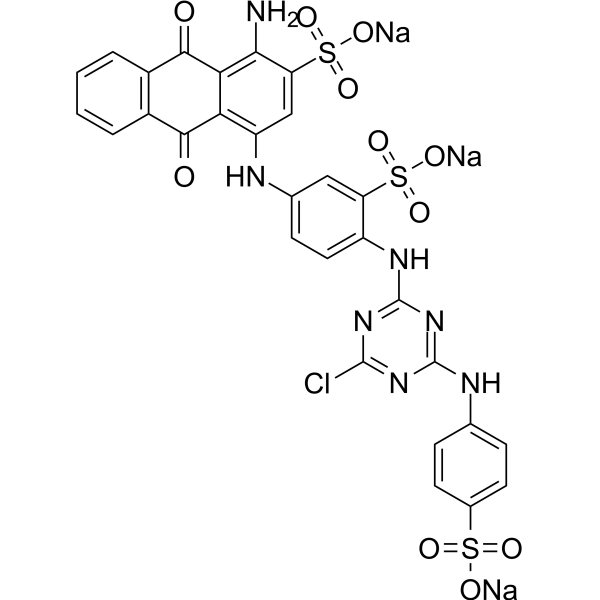
- HY-110237
-
|
|
P2X Receptor
Calcium Channel
|
Cardiovascular Disease
|
|
BX430 is a potent and selective noncompetitive allosteric human P2X4 receptor channels antagonist with an IC50 of 0.54 μM. BX430 has species specificity. BX430 is used for chronic pain and cardiovascular disease.
|
-

- HY-N7740
-
|
|
P2Y Receptor
Endogenous Metabolite
|
Others
|
|
Adenosine 2',5'-diphosphate sodium is a competitive P2Y1 antagonist. Adenosine 2',5'-diphosphate sodium exhibits non-selective antagonism at recombinant and human platelet P2X1 receptors .
|
-
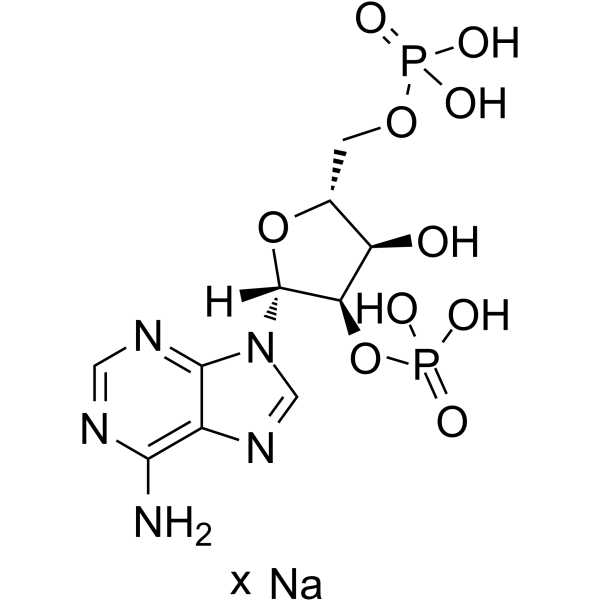
- HY-108671
-
|
|
P2X Receptor
|
Neurological Disease
|
|
NF110 is a P2X3 receptor antagonist (Ki = 36 nM) and inactive toward P2Y receptors stably expressed (IC50s > 10 M). NF110 blocks alphabeta-methylene-ATP-induced currents (IC50 = 527 nM) in rat dorsal root ganglia neurons .
|
-
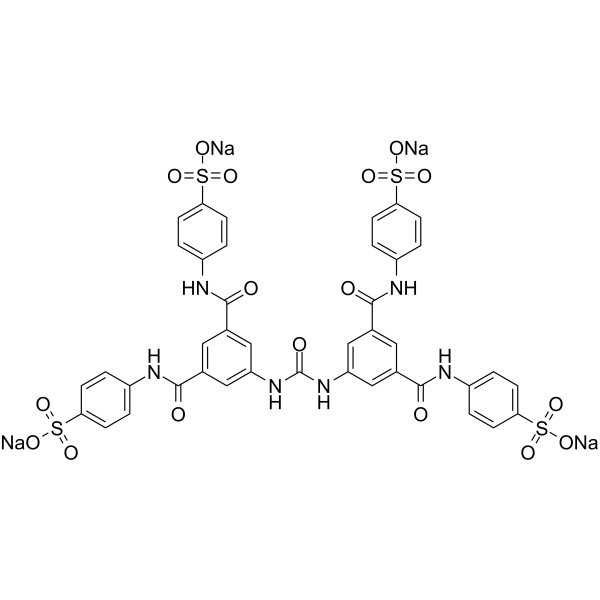
- HY-108670
-
|
|
P2X Receptor
|
Inflammation/Immunology
|
|
AZ11645373 is a highly selective and potent antagonist at human but not rat P2X7 receptors,AZ11645373 inhibits ATP-evoked IL-1β release from lipopolysaccharide-activated THP-1 cells , with an IC50 value of 90 nM .
|
-

- HY-108675
-
|
|
MMP
P2X Receptor
|
Infection
Cancer
|
|
PPNDS tetrasodium is a selective and competitive meprin β inhibitor (IC50: 80 nM, Ki: 8 nM), and also inhibits ADAM10 (IC50: 1.2 μM). PPNDS tetrasodium is also a P2X1 receptor antagonist. PPNDS is an agonist for the ATP receptor of Paramecium. PPNDS tetrasodium potently inhibits polymerases from viruses. PPNDS tetrasodium can be used in the research of infection and cancers .
|
-
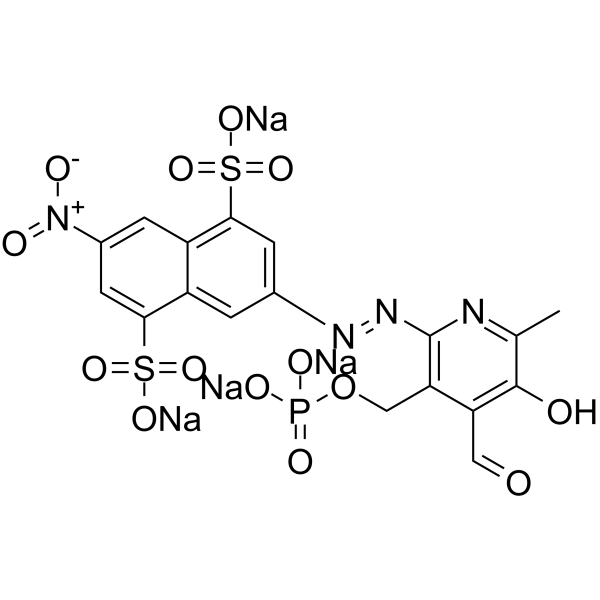
- HY-101911
-
5-BDBD
2 Publications Verification
|
P2X Receptor
|
Neurological Disease
|
|
5-BDBD, a potent and selective P2X4 receptor antagonist, inhibits rP2X4R-mediated currents, with an IC50 of 0.75 μM. 5-BDBD completely blocks the basal and acute hyperalgesia induced by nitroglycerin (NTG) .
|
-
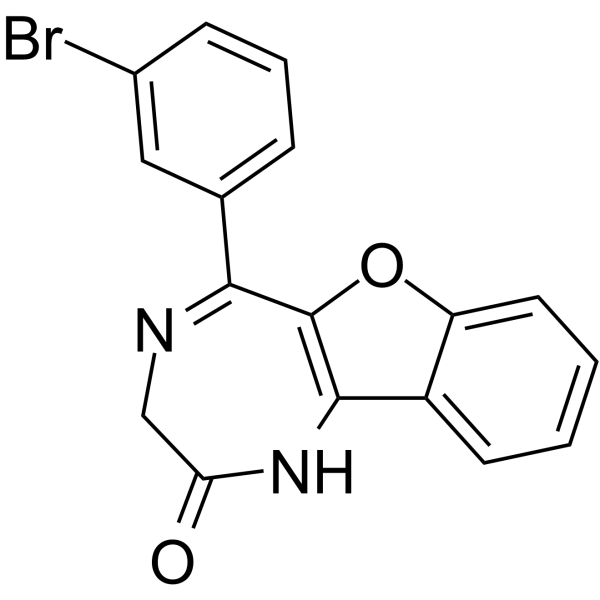
- HY-136026
-
|
BLU-5937
|
P2X Receptor
|
Inflammation/Immunology
|
|
Camlipixant (BLU-5937) a potent, selective, non-competitive and orally active P2X3 homotrimeric receptor antagonist with an IC50 of 25 nM against hP2X3 homotrimeric. Camlipixant shows potent anti-tussive effect and no taste alteration. Camlipixant can be used for the research of unexplained, refractory chronic cough .
|
-
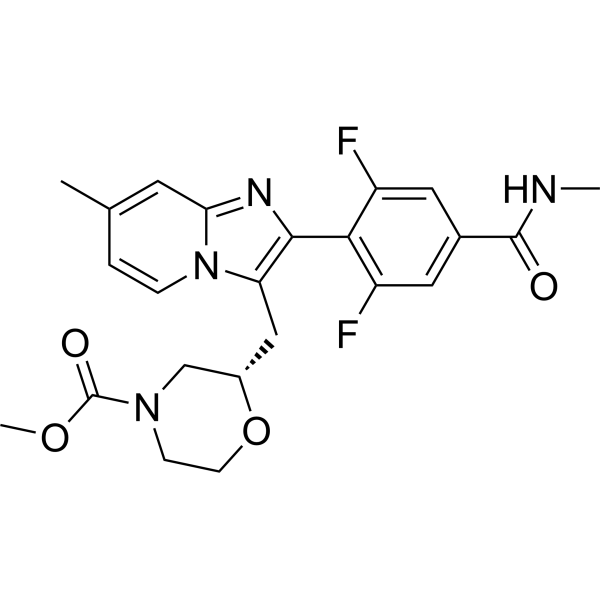
- HY-137888A
-
|
oATP trisodium salt
|
P2X Receptor
NOD-like Receptor (NLR)
|
Inflammation/Immunology
|
|
Oxidized ATP (oATP) trisodium salt is a broad-spectrum P2 receptor inhibitor. Oxidized ATP trisodium salt irreversibly antagonizes P2X7R activation. Oxidized ATP trisodium salt inhibits c-reactive protein (CRP)-induced NLRP3 inflammasome activation. Oxidized ATP trisodium salt can be used for research of atherosclerosis .
|
-

- HY-132981
-
|
|
P2X Receptor
|
Neurological Disease
|
|
Lu AF27139 is a potent, selective, and orally active antagonist of P2X7 receptor (IC50s of 12 and 2.4 nM for human and rat, Kis of 22, 54, and 13 nM for mouse, human, and rat, respectively). Lu AF27139 has rodent-active and CNS-penetrant character. Lu AF27139 has the potential for the research of CNS diseases .
|
-

- HY-13290
-
|
|
CaMK
P2X Receptor
|
Metabolic Disease
Cancer
|
|
KN-62 is a selective and reversible inhibitor of calmodulin-dependent protein kinase II (CaMK-II) with a Ki of 0.9 μM for rat brain CaMK-II. KN-62 directly binds to the calmodulin binding site of CaMK-II. KN-62 displays noncompetitive antagonism at P2X7 receptors in HEK293 cells, with an IC50 value of approximately 15 nM.
|
-
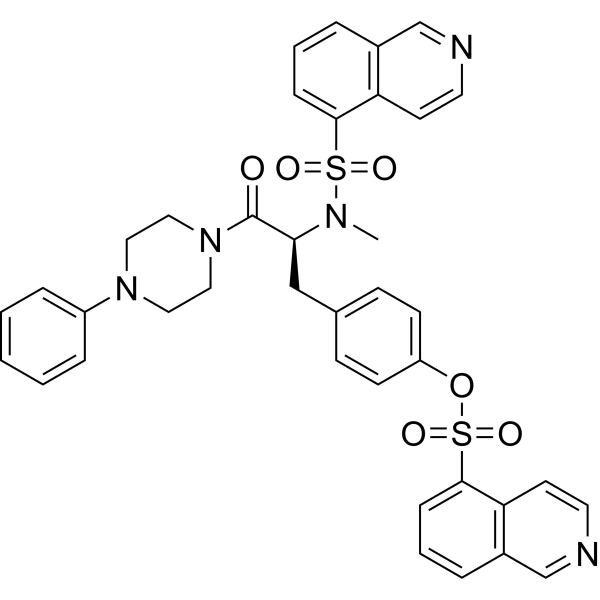
- HY-N9182
-
|
Physalien
|
Adiponectin Receptor
P2X Receptor
Autophagy
|
Inflammation/Immunology
|
|
Zeaxanthin dipalmitate (Physalien) is a wolfberry-derived carotenoid, has anti-inflammatory and anti-oxidative stress effects. Zeaxanthin dipalmitate directly interact with p2X7 receptor (Kd=81.2 nM) and adiponectin receptor 1 (AdipoR1; Kd=533 nM) in a positive dose-dependent manner. Zeaxanthin dipalmitate restores mitochondrial autophagy functions suppressed by ethanol intoxication. Zeaxanthin dipalmitate can be used in the research of alcoholic fatty liver disease (AFLD) and retinitis pigmentosa (RP) .
|
-

- HY-105285
-
|
Neu-P11
|
Melatonin Receptor
5-HT Receptor
P2X Receptor
TRP Channel
Sodium Channel
|
Neurological Disease
|
|
Piromelatine (Neu-P11) is a melatonin MT1/MT2 receptor agonist, serotonin 5-HT1A/5-HT1D agonist, and serotonin 5-HT2B antagonist. Piromelatine (Neu-P11) possesses sleep promoting, analgesic, anti-neurodegenerative, anxiolytic and antidepressant potentials. Piromelatine (Neu-P11) also possesses pain-related P2X3, TRPV1, and Nav1.7 channel-inhibition capacities .
|
-
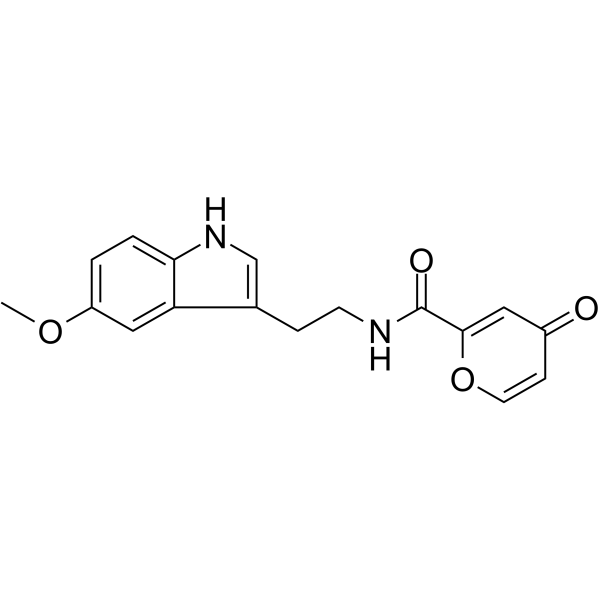
- HY-15310
-
Ivermectin
Maximum Cited Publications
18 Publications Verification
MK-933
|
Flavivirus
Dengue virus
Parasite
HIV
Mitophagy
HSV
SARS-CoV
Antibiotic
Autophagy
Bacterial
|
Infection
Cancer
|
|
Ivermectin (MK-933) is a broad-spectrum anti-parasite agent. Ivermectin (MK-933) is a specific inhibitor of Impα/β1-mediated nuclear import and has potent antiviral activity towards both HIV-1 and dengue virus. It is a positive allosteric effector of P2X4 and the α7 neuronal nicotinic acetylcholine receptor (nAChRs). Ivermectin also inhibits bovine herpesvirus1 (BoHV-1) replication and inhibits BoHV-1 DNA polymerase nuclear import . Ivermectin is a candidate therapeutic against SARS-CoV-2/COVID-19 .
|
-
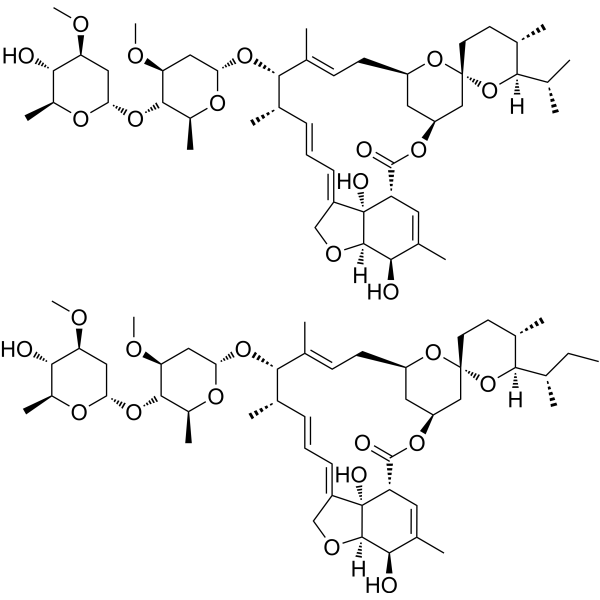
- HY-122575
-
|
|
P2X Receptor
Influenza Virus
Topoisomerase
MicroRNA
Apoptosis
|
Infection
Neurological Disease
Inflammation/Immunology
|
|
Aurintricarboxylic acid is a nanomolar-potency, allosteric antagonist with selectivity towards αβ-methylene-ATP-sensitive P2X1Rs and P2X3Rs, with IC50s of 8.6 nM and 72.9 nM for rP2X1R and rP2X3R, respectively . Aurintricarboxylic acid is a potent anti-influenza agent by directly inhibiting the neuraminidase . Aurintricarboxylic acid is an inhibitor of topoisomerase II and apoptosis . Aurintricarboxylic acid is a selective inhibitor of the TWEAK-Fn14 signaling pathway . Aurintricarboxylic acid also acts as a cystathionine-lyase (CSE) inhibitor with an IC50 of 0.6 μM . Aurintricarboxylic acid is a modifier of miRNAs that regulate miRNA function, with an IC50 of 0.47 µM .
|
-

| Cat. No. |
Product Name |
Target |
Research Area |
-
- HY-P1137
-
|
|
Peptides
|
Others
|
|
10Panx is a biological active peptide. (This is a Pannexin-1 (Panx1) mimetic blocking peptide. Pannexin-1 is a recently identified membrane protein that can form gap junction-like connections allowing intercellular passage of dyes when overexpressed in two adjacent oocytes or mammalian epithelial cell lines. Blockade of pannexin-1 in macrophage endogenously expressing the ATP-gated P2X7 receptor (P2X7R) blocks the initial dye uptake, but not the ionic current, and also blocks processing and release of interleukin-1b (IL-1b) in response to P2X7R activation.)
|
-
- HY-P1330
-
|
|
P2X Receptor
|
Inflammation/Immunology
|
|
Purotoxin 1 is a P2X3 receptor inhibitor. Purotoxin 1 shows antinociceptive properties in animal models of inflammatory pain. Purotoxin 1 can be isolated from the venom of the wolf spider Geolycosa sp .
|
| Cat. No. |
Product Name |
Category |
Target |
Chemical Structure |
| Cat. No. |
Product Name |
Chemical Structure |
-
- HY-16322S
-
|
|
|
Minodronic acid-d4 is deuterium labeled Minodronic acid. Minodronic acid (YM-529) is a third-generation bisphosphonate that directly and indirectly prevents proliferation, induces apoptosis, and inhibits metastasis of various types of cancer cells. Minodronic acid (YM-529) is an antagonist of purinergic P2X2/3 receptors involved in pain[1][2].
|
-

Your information is safe with us. * Required Fields.
Inquiry Information
- Product Name:
- Cat. No.:
- Quantity:
- MCE Japan Authorized Agent:














































































